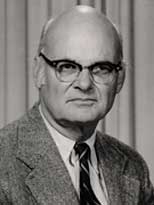E. Cary Brown, a leading expert on fiscal policy and the economics of taxation and a member of the MIT economics faculty for more than 60 years, passed away on June 8. He was 91.
As a professor of economics at MIT, Brown taught a wide range of graduate and undergraduate courses on tax policy design, statistical methods for economics and the economics of fiscal policy.
A memorial service will be held later this year, and details will be posted on the MIT economics department web site at econ-www.mit.edu/.
Brown was born on April 14, 1916, in Bakersfield, Calif. He received the B.A. degree from the University of California at Berkeley in 1937 and pursued graduate work in economics at Berkeley and Harvard. His graduate studies were interrupted by World War II. Brown served as an economist at the War Production Board in 1940-41 and as an economist at the Division of Tax Research at the U.S. Treasury Department between 1942 and 1947. He received his Ph.D. in economics from Harvard in 1948.
Brown joined the MIT faculty in 1947 and was promoted to full professor in 1958. He was a Guggenheim Fellow, a Ford Foundation Faculty Fellow and a Fellow of the American Academy of Arts and Sciences. He served as department head for Economics for 18 years, presiding over a period of departmental expansion and a time when MIT achieved recognition as one of the world's leading economics departments. He retired from the MIT faculty in 1986 and served as an emeritus professor until his death.
Brown was widely acclaimed for his seminal research on the design of depreciation allowances, the income tax provisions that permit corporations and other investors who purchase long-lived assets to claim tax deductions as these assets decay. In a classic 1948 study, "Business Income Taxation and Investment Incentives," Brown outlined a fundamental set of relationships between the investment credit a firm receives when it makes an investment, the present discounted value of subsequent depreciation allowances and the effective tax burden on new investments. His insights have remained a touchstone for virtually all subsequent research on this issue and still feature in the public policy debate on the choice between income and consumption taxation.
Brown was also an expert on broader issues of fiscal policy. His 1956 paper on "Fiscal Policy in the Thirties: A Reappraisal" was one of the first applications of the full-employment budget deficit concept. In contrast to the then-prevailing wisdom, the study suggested that fiscal policy had not been particularly expansionary through much of this period, thereby calling into question the extent to which fiscal policy could have contributed to the U.S. economy's recovery from the depths of the Great Depression.
Brown was a leader in the post-World War II research effort to understand the economic effects of different tax instruments and to design an equitable and efficient tax system. Policy-makers often sought his advice on questions of tax policy, and he was a frequent consultant to the U.S. Treasury Department. In the early 1960s, he was actively involved in the Kennedy Administration's consideration of proposals for accelerated depreciation for capital goods, and he was one of the architects of the 1962 investment tax credit.
Brown was an avid tennis player throughout his life. After his retirement from MIT, he played on the Super Seniors Tennis circuit, competing throughout the United States and winning several competitions in various age groups. He remained an active tennis player until he was 88.
A long-time resident of Concord, Brown is survived by three sisters, Phyllys Ohanian of Newton, Mass., Molly Canan of Philomath, Ore., and Constance Morse of Plymouth, Mich.; and one brother, Lewis Brown of New York City. He is also survived by his daughters, Rebecca Brown Corwin of Roslindale, Mass., and Gretchen Brown Rossman of Amherst, Mass.; two granddaughters, three great-grandchildren and two stepchildren.
His first wife, Tomlin E. (Edwards) Coggan, died in 1994; they were divorced. His second wife, Margaret Durham, resides in Evergreen, Colo.; they were divorced. In lieu of flowers, the family requests that contributions in Brown's name be made to the international labor rights organization, Business & Human Rights, 235 Cucamonga Ave., Claremont, CA 91711 or www.business-humanrights.org/Aboutus/Makeadonation.






